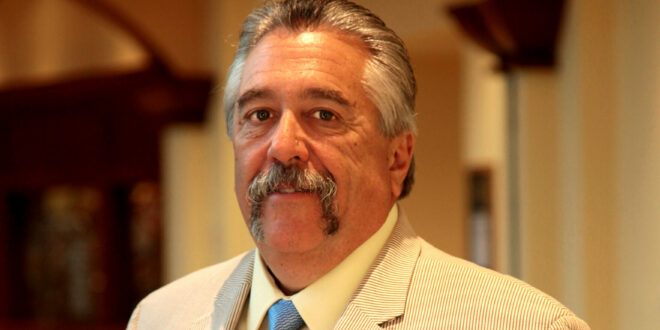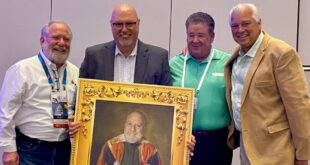Ron Siarnicki Named 2022 Fire Sprinkler Advocate of the Year
While many can say they “grew up” in the fire service, Ron Siarnicki, executive director of the National Fallen Firefighters Foundation (NFFF), was raised in the fire service and the fire station. From serving as a volunteer firefighter as a teenager to two careers—one as a fire chief and one leading the Foundation—Siarnicki has dedicated his life to protecting residents, firefighters, and their loved ones. And along this journey, he has always promoted fire sprinklers as an essential component of safety. For his relentless drive to protect America’s citizens, the American Fire Sprinkler Association (AFSA) is honored to present its 2022 Fire Sprinkler Advocate of the Year award to Ron Siarnicki.
Siarnicki’s family has a long history in the town of Monessen, Pennsylvania, 30 miles from Pittsburgh, which was founded in 1898. Situated along the shores of the Monongahela River, the area quickly developed with a prominent steel mill replicated from one in Germany and other industries.
Siarnicki’s grandfather immigrated from Poland to Monessen. He became a volunteer firefighter with the Monessen Fire Department, which was established in 1899 and served as the only department for the borough. Eventually, the need for a second station was evident, and Monessen Fire Department #2 was organized in 1946 with Siarnicki’s father, John, as a charter member. He also served as president of the firehouse, and Siarnicki’s mother, Tillie, was an auxiliary member supporting the department.

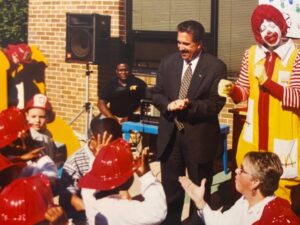
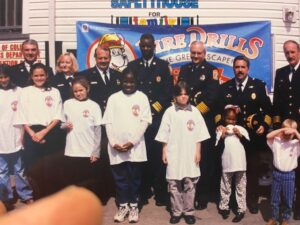
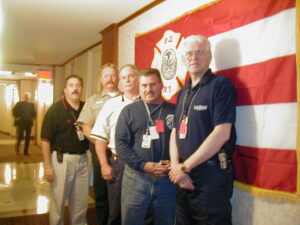
Photos above, clockwise: Siarnicki and others reviewing the public safety plan at Jack Kent Cook Stadium. Siarnicki attending two community-based outreach programs that included smoke alarm, CO alarm, and fire sprinkler information to promote life safety. The NFFF team in New York at the NFFF Operations Center during its effort to support the FDNY as a result of 9/11.
“The fire station was a mile from our house,” Siarnicki remembers. “Our lives revolved around the fire station. It had a social hall where we held holiday and community events. I basically grew up in that station.”
At 18, Siarnicki was eligible to serve as a volunteer firefighter and signed up while still in high school. “The school would even let us leave to respond to a fire if the call went out,” he reminisces.
Siarnicki spent two-and-a-half years with the fire department. “I knew I wanted my career to be in the fire service, but there weren’t a lot of opportunities in Monessen nor the cities close to home,” Siarnicki says. “Luckily, my sister had moved to Washington, D.C., and had married a firefighter with Prince George’s County. He said they were hiring, and I ought to apply.”
Siarnicki applied, and a year later, in 1978, he was hired as a firefighter in Prince George’s County Fire/EMS Department. Little did he know, he would rise to become fire chief of the department and be a prominent figure in the residential fire sprinkler movement.
Protecting Prince George’s County Residents
Siarnicki spent 24 years in Prince George’s County, working his way up to become fire chief in 1998. As he was “coming up” the ranks, the county was moving forward with residential fire sprinkler requirements. “As the population and construction grew within the county, so did fire deaths, injuries, and fire loss costs,” he comments. ‘After a considerable amount of work led by the county’s fire service, legislation was approved by the Prince George’s County Council and signed into law in 1987.”
The law was enacted in stages over five years. The first phase required one- and two-family model homes to feature residential fire sprinkler systems by February 1, 1988. All multi-family residences were affected on June 30, 1988, with all townhouses starting on January 1, 1989.
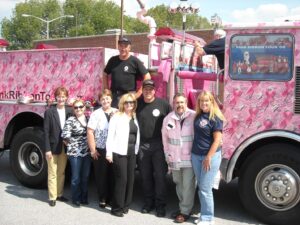
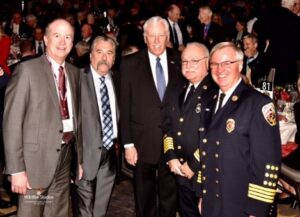
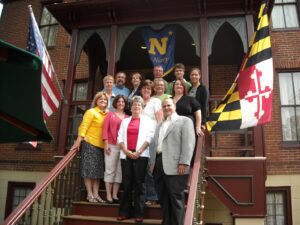
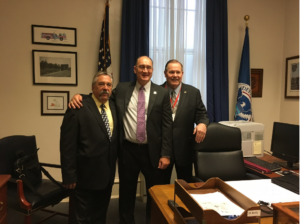
Photos above, clockwise: The NFFF team working to promote firefighter cancer issues across the country as a part of the Pink Ribbon Tour. Leadership from NFPA, NFFF, and NVFC visited with Congressman Steny Hoyer (center) at a CFSI Fire Service Dinner. The PGC Fire Department hosted the American Burn Association’s committee meetings, which included a visit to the U.S. Naval Academy. Siarnicki working with then U.S. Fire Administrator Keith Bryant and Chief Dennis Compton, then chair of the NFFF board, on issues relative to the NFFF and USFA
“A large number of three-story apartment buildings were burning back then—garden apartments, townhouses, and duplexes,” remembers Siarnicki. “We wanted to protect those structures early on and then phase in single-family dwellings so the building community could prepare for each component.”
On January 1, 1992, the final stage of the law went into effect, stating that all single-family homes must be fully protected by an NFPA-approved 13D residential fire sprinkler system. The biggest groups fighting the ordinance were realtors, the building community, and the development community. To win their support, the county worked to find a “win-win” situation for everyone, including considerations such as offsetting the anticipated costs of the fire sprinkler system, providing marketing materials that would increase system purchases by home buyers, allowing communities to have a denser population, and increasing the value and demand for homes containing these systems.
“The entire process was a learning experience for me,” Siarnicki notes. “I was working in the fire chief’s office as a management intern then. My first executive thesis was on the topic.” Twelve years later, he would write another report on the effectiveness of the ordinance, showing that the projections were true—fire sprinkler systems saved lives and dollars. The actual monetary results indicated a total property savings of over $38 million and, most importantly, 154 lives that were saved as a direct result of residential fire sprinklers.
In addition, a 15-year study further showed that 89 percent of total fire deaths in the county occurred in residential dwellings. One hundred and one people died in single-family and townhouse fires with no fire sprinklers, and there were 328 civilian injuries in single-family and townhouse fires with no fire sprinklers. In contrast, there were zero fire deaths in homes protected with fire sprinklers.
One innovative project that Siarnicki oversaw was the construction of Jack Kent Cook Stadium. The state-of-the-art football facility seats more than 78,000 patrons and is the largest single public assembly structure located within the jurisdiction. During the opening game at the new stadium, NFPA Chief of Security Milton E. Ahlerich stated, “This plan, developed in Prince George’s County, Maryland, serves as a model for the National Football League.”
When he became fire chief in 1998, Siarnicki oversaw the entire fire/EMS department, including directing, coordinating, and assessing the work of division managers, bureau chiefs, and other staff. Fire department programs under his jurisdiction included emergency fire; emergency preparedness and rescue services; basic ambulance, advanced life support, and battalion rescue ambulance services; hazardous materials response; and high-rise and underwater rescues. He also coordinated activities with citizens and governmental agencies while serving on various county and other committees to accomplish goals set by the county executive and council programs.
“I had a great career in Prince George’s County,” remarks Siarnicki. “My time there was educational and very rewarding as we worked to make our communities better and safer.”
Protecting America’s Heroes
After 24 years of service with the department, Siarnicki knew he needed to start planning his life after the fire service. That’s when he found an opportunity to serve as executive director of the NFFF.
“I didn’t expect to leave Prince George’s County as soon as I did,” says Siarnicki. “I had heard about the position at the Foundation and decided to apply, figuring it was a long shot. Hal Bruno, then chairman of the board of directors for the Foundation, whom I’d known for years, called me soon after and said if I wanted the job, I could have it. I started July 1, 2001.”
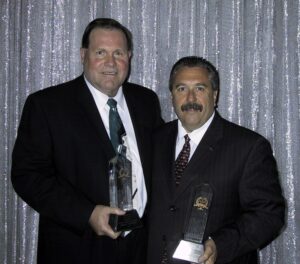
As executive director, Siarnicki oversees all programs, services, and activities of the Foundation, which includes the National Fallen Firefighters Memorial Weekend, survivor support programs, fire service training and support programs, the national memorial park, and working with the entire fire service community to develop and implement programs that will reduce the number of line-of-duty deaths that occur in the United States each year.
AFSA’s Chesapeake Bay Chapter is a long-time supporter of the Foundation and its efforts. Its annual golf tournament has benefited the organization for over 30 years and raisesd over $150,000. “We are grateful to AFSA and its Chesapeake Bay Chapter for its fundraising, not just for the Foundation but also for the fire service,” notes Siarnicki.
The chapter’s 2022 golf outing will be held on September 15 at The Links at Challedon in Mt. Airy, Maryland. For more information about sponsoring or playing in this year’s tournament, email Chapter Executive Director Danielle Fowler at daniellef@pottersignal.com.
“I have been the executive director for the Chesapeake Bay Chapter for over 15 years now, and we have continued to use the Foundation as our primary donation for our annual golf tournament,” comments Fowler, Northeast sales manager, Potter Signal. Mount Airy, Maryland. “Some of our founding members are the reason this charity is special to our chapter. Both Jack Medovich and Greg Prentice had multiple generations of firefighters in their families. We have been fortunate that we’ve only been guests at the memorial each year, but to know that fellow brothers and sisters have passed working to save others is why we continue to keep it as our beneficiary.”
Siarnicki says the new job was “baptism by fire.” A few months after joining the Foundation, 9/11 hit. “We moved operations to New York City and stayed there for almost 12 weeks straight to get a program in place for firefighter and family support,” Siarnicki states. “We learned a lot during that time, and many of the pieces that were developed for 9/11 have been used throughout the country since then. Each time there’s a need, we try to build something good and then make it a bit better each time.”
One program born from 9/11 is “Everyone Goes Home”—firefighter life-safety initiatives jointly developed by representatives of the major fire service constituencies to reduce firefighter line-of-duty deaths and injuries. The Foundation was tasked with executing these initiatives throughout the fire service and developing material to support their implementation.
One of those 16 initiatives is #15 “Code Enforcement and Sprinklers.” According to the site, “Advocacy must be strengthened for the enforcement of codes and the installation of home fire sprinklers. The term ‘fire prevention,’ as used here, means preventing accidental fires from starting and, when they do start, minimizing their growth or extinguishing them prior to human intervention. A successful effort in fire prevention will mean fewer fire responses by firefighters because of a reduction in fires and less dangerous working conditions on the fire ground as a result of smaller contained fires. With fewer fire responses and smaller, contained fires, and a better-protected public, it is clear that there will be fewer firefighter injuries and fatalities – which is the goal of our overall efforts. The 15th Initiative asks us to advocate for stronger codes and laws which will decrease the number and severity of structural and residential fires to keep our firefighters out of harm’s way.”
“We’ve lived through the belief that firefighters will be out of a job if a fire sprinkler system is present and that prevention, in general, would put us out of a job,” says Siarnicki. “Most firefighters have realized fire sprinklers work parallel with the fire service industry. If we can ensure everyone gets out of the structure by the time firefighters arrive through working smoke and CO2 alarms and fire sprinklers, firefighters can do what they must do in a safer environment. Property can be replaced. Lives cannot. Having the prevention pieces improves the safety of the public and the fire service community.”
Ensuring Life Safety for Everyone
Siarnicki also finds time to serve the industry and people affected by fire through other organizations. He became involved with the Phoenix Society for Burn Survivors when his nephew was burned, and he was looking for some programs to help him. “I found Amy Acton at a booth at an NFPA conference, and we developed a friendship. Next thing you know, I’m the fire service representative on the board and then president of the Society’s board of directors,” he says, laughing. “That led to my involvement with the American Burn Association.”
During his time as Prince George’s County fire chief, Siarnicki put into policy that any firefighter who received burn injuries went to a burn unit. “The level of care is unique at a burn center. Emergency rooms care for burn victims as best they can, but burn centers are specialized, and receiving that care early makes all the difference in the outcome.”
Siarnicki is also on the board of directors for the Home Fire Sprinkler Coalition (HFSC). “I was asked to serve because of my commitment to residential fire sprinklers,” comments Siarnicki. “It was the perfect opportunity to promote them and tell the Prince George story.”

During his time in Prince George’s County, Siarnicki became involved with the Maryland State Firemen’s Association, which works to serve, promote, advocate, and represent the interests of the volunteer fire, rescue, and emergency medical services in Maryland. He currently serves as treasurer of the association.
Siarnicki has served on numerous other organizations, including chairing the National Advisory Committee for the Congressional Fire Services Institute and being appointed to the National Fire Heritage Center board of directors. He is also a member of several other groups, including the National Fire Protection Association (NFPA), International Association of Fire Chiefs Eastern Division, International Association of Fire Fighters, International Society of Fire Service Instructors, Institution of Fire Engineers, Maryland Fire Chiefs Association, and Metropolitan Fire Chiefs Association.
Siarnicki has received numerous awards, including the Dr. John Granito Award for Excellence in Fire Leadership and Management Research, the Phoenix Society for Burn Survivors’ Alan and Delwyn Breslau Award, the International Fire Service Training Association’s Everett E. Hudiburg Award, the American Burn Association Dr. John Moncrief Award, and the United Fire Communities Volunteer Fire Department Fire Chiefs Award. He has been inducted into the Prince George’s County Fire/EMS Department Hall of Fame and named a University of Maryland University College Distinguished Alumnus of the Year.
Siarnicki graduated with a Bachelor of Science degree in fire science and management and a Master of Science degree in technology management from the University of Maryland College Park and is a graduate of the Executive Fire Officer Program at the National Fire Academy in Emmitsburg, Maryland.
It seems like the word gets out about Siarnicki, and he’s often asked to join local efforts and organizations. “When I moved to Kent Island in the Chesapeake Bay, I’d find an application in my mailbox for the community’s volunteer firehouse every week. I’d go down and tell them ‘no,’ but guess who has now been president for ten years,” he says with a laugh.
Family Time and Downtime
Siarnicki has been married to his high school sweetheart Jan for over 40 years, and they enjoy spending downtime together. “On Saturdays, we try to get out to our 10-acre farm in Caroline County,” he says. “I also have a couple of antique fire trucks that I enjoy tooling around with.”
Siarnicki and his wife sit on the board of directors for the Enchanted Haven Horse Rescue, a not-for-profit private foundation that works with local and regional entities to locate abandoned, abused, and neglected horses who are then nursed back to good health.
“I assume I’ll soon be retiring after being with the Foundation for 21 years,” comments Siarnicki. “Then I may try to continue with some of my charities and enjoy life—ride tractors and enjoy fire trucks.”
Honoring a Dedication to Life Safety
AFSA’s Fire Sprinkler Advocate of the Year award was created to honor individuals not directly involved in the fire sprinkler industry whose efforts have had a national impact in advancing life safety and property protection through the use of automatic fire sprinklers. Each year, AFSA’s Legislative Committee selects a recipient from a pool of nominations. Their nomination is then approved by the AFSA Board of Directors.
“When Chief Siarnicki was on the management team for the Prince George’s County Maryland Fire & Rescue Department, the department was one of the first in the nation to mandate that all new townhomes and new single-family homes were to be sprinklered,” comments AFSA Chair of the Board Jack Medovich, P.E., Fire & Life Safety America, Richmond, Virginia. “This eventually carried forward to include the entire state of Maryland, based upon the tremendous data and results found in Prince George’s County. Chief Siarnicki is very deserving of this award, and I look forward to presenting it to him at AFSA 41,” comments AFSA Chair of the Board Jack Medovich, P.E., president, CEO and founding partner of Fire & Life Safety America in Richmond, Virginia.
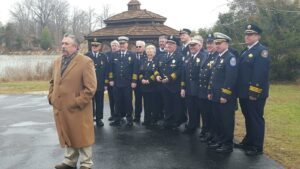
“Chief Siarnicki’s dedication to the fire service and, in particular, his commitment toward promoting fire sprinkler legislation that enhances the safety of our communities across the country is unprecedented,” comments AFSA Senior Director of Membership & Chapter Support Bruce Lecair, who serves as staff liaison to the AFSA Legislative Committee.
“Chief Siarnicki is more than just a unique figure in the world of firefighting,” says AFSA President Bob Caputo, CFPS. “A third-generation firefighter, his tireless dedication to fire- and life-safety training programs, firefighter safety, and support of the families of fallen fighters are unparalleled. The American Fire Sprinkler Association is honored to be able to acknowledge his career-long efforts and his support of the fire sprinkler industry.”
“From the time Ron stepped onto a fireground more than 40 years ago to his current role as the head of the National Fallen Fire Fighters Foundation, he has championed efforts that keep firefighters safe and ensure they go home at the end of their shifts,” says Lorraine Carli, president of HFSC and vice president of outreach and advocacy for NFPA. “His informed and passionate drive for sprinklers is central to his advocacy work and undoubtedly has saved lives and educated countless individuals on the value of sprinklers.”
Siarnicki shies away from all the praise and accolades. “I am honored to have been selected by AFSA to receive this award. My life has been committed to making things better than how I found them, and that includes my efforts for fire prevention and life safety.”
He continues, “All of my accomplishments have been a result of the support and assistance I have gotten from family, friends, and coworkers along the way; no one can do it alone. I appreciate this recognition and hope that it will inspire others to carry forward all of the work that has been done to this point in time in an effort to make our communities safer and a great place to live, work, and play.”
Siarnicki will be presented with AFSA’s Fire Sprinkler Advocate of the Year award during the general session at AFSA41: Convention, Exhibition & Apprentice Competition on October 16 at the Bellagio Las Vegas. To learn more about and register for AFSA41, visit www.firesprinkler.org/AFSA41.
Fire Sprinkler Advocate of the Year Award Recipients
1997 Dan Jones, Chapel Hill, North Carolina Fire Chief
1998 John Vendetta, Hartford Fire Chief
1999 V.J. Bella, Louisiana State Fire Marshal
2000 Dennis Compton, Mesa, Arizona Fire Marshal
2001 George Miller, National Fire Protection Association
2002 Jim Ford, Scottsdale, Arizona Fire Department
2003 Gary Keith, National Fire Protection Association
2004 Jan Gratton, Fire & Life Safety Educator, Covina, California Fire Department
2005 Senator Rick Santorum (R-PA)
2006 Meri-K Appy, Home Safety Council
2007 Rep. Jim Langevin (D-RI)
2008 Ron Hazelton, Home Improvement Expert
2009 Olin Greene, U.S. Fire Administrator
2010 Jim Shannon, National Fire Protection Association
2011 Jeff Feid, State Farm Insurance
2012 Tonya Hoover, California State Fire Marshal
2013 William Barnard, Maryland State Fire Marshal
2014 Peg Paul, Home Fire Sprinkler Coalition
2015 Ed Van Walraven, Aspen, Colorado Fire Marshal
2016 Ed Altizer, Virginia State Fire Marshal
2017 Randy Miller, Camas, Washington Fire Marshal
2018 Richard Smith, Maryland State Firemen’s Association
2019 Amy Acton, Phoenix Society for Burn Survivors
2020 Brian Geraci, Maryland State Fire Marshal
2021 H. Butch Browning, Louisiana State Fire Marshal
2022 Ron Siarnicki, National Fallen Firefighters Foundation
EDITOR’S NOTE: All three of AFSA’s annual awards—the Henry S. Parmelee Award, Fire Sprinkler Advocate of the Year Award, and Young Professional of the Year Award—accept nominations year-round at www.firesprinkler.org/awards.
 Sprinkler Age A Publication of the American Fire Sprinkler Association
Sprinkler Age A Publication of the American Fire Sprinkler Association
